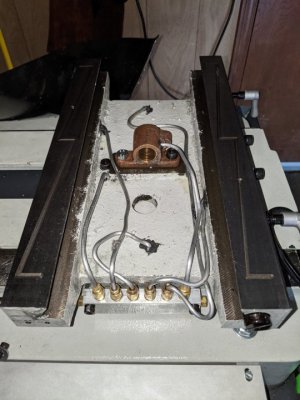Has anyone replaced the factory one shot oiler manifold on the y carriage to add ports for the x and y screws? I'm converting my 833TV with the heavy metal kit and the Z screw gets an oil line but the X and Y don't from the factory. Seems a little oversighted to skip those as they still need lube and why do it by hand when I already have the one shot. I know I can make a block but I figured it best to replace/reroute everything while its all in pieces.
-
Welcome back Guest! Did you know you can mentor other members here at H-M? If not, please check out our Relaunch of Hobby Machinist Mentoring Program!
You are using an out of date browser. It may not display this or other websites correctly.
You should upgrade or use an alternative browser.
You should upgrade or use an alternative browser.
833TV CNC conversion oiler manifold
- Thread starter joeblow65
- Start date
I replaced the 4 way manifold with a 6 way adjustable manifold. Mine has the adjustable needle valves on the bottom so I can regulate the flow to the X and Y axis nuts. It seemed to work pretty good. I need to move the set up to another machine and have been trying to get info on the combined metering/check valve ports that seem to come on higher end factory set ups. Supposedly the one way valve will keep the oil from pulling back and causing you to get no oil when you pump. However most of the system I could find pictures of seem to have them located right past the manifold with long lengths of line run after that. Seems to me like the line could still drain from after the check valve. Maybe the lines on those systems are somehow sealed into the castings and the resistance from the ways keeps it from running out. I know on our machines the line is just sitting in a drilled out hole that leads to the ways. I added some RTV sealant around the holes as I noticed oil was pumping back out of the hole.
Anyway, here is a picture. You need to be very careful routing the X axis line as the cutouts in the ends of the table are a close fit to the X axis bronze nut and you can damage the line when you reinstall the table.
Another thing, the lines that are currently run only oil the horizontal (and vertical for Z axis) side of the way, they don't oil the dovetail side. The one shot system on these is really just for marketing, it's not executed well enough in it's factory form to properly provide lube everywhere that needs it. There is a chance that oil from the horizontal surface of the X axis drips down on to the dovetail below it. But there's no way the oil from the horizontal surface of the Y axis is climbing up to the dovetail above it. Likewise on the Z axis.
Anyway, here is a picture. You need to be very careful routing the X axis line as the cutouts in the ends of the table are a close fit to the X axis bronze nut and you can damage the line when you reinstall the table.
Another thing, the lines that are currently run only oil the horizontal (and vertical for Z axis) side of the way, they don't oil the dovetail side. The one shot system on these is really just for marketing, it's not executed well enough in it's factory form to properly provide lube everywhere that needs it. There is a chance that oil from the horizontal surface of the X axis drips down on to the dovetail below it. But there's no way the oil from the horizontal surface of the Y axis is climbing up to the dovetail above it. Likewise on the Z axis.
Attachments
Last edited:
- Joined
- Jan 20, 2015
- Messages
- 359
You really want an oil block like a vogel/skf or bijur that is metered and has a check in it. Or even better would be a MX trabon or similar block. They actually pump the metered amount (very small amount needed for the ball screw) and as they release pressure the check ball allowing the next cycles oil to flow around it and fill the chamber.
Trabons work a little differently as they have small bidirectional pistons that are specially ported. The first block cycles pumping its metered oil to the lubrication point, shifts the piston over which porting allows the next block to do the same and so on. the bottom block moves over and then forces the top block back the other way and the cycle continues.
The nice part about the MX trabon is that they cant fail and you don't know about it. The first block has a cycle indicator rod. This can be viewed visually or have a prox mounted on it and monitored by the plc. Easy to trouble shoot as well as once you know its not functioning you can start unhooking lines off the block and when it starts cycling with a line unhooked you know that you have found the plugged line.
Bijur and the vogel/skf units monitor if things go back to zero pressure with a pressure switch which is prone to issues over time. Also they can have a plug or piston/check fail and you don't have a clue until damage is done at that lube point because it has not been getting any.
I would hightly suggest not using any type of needle valves. They make it hard to adjust because choking off one pushes more oil elsewhere. And a plug would once again not be noticed but over oil other points.
Trabons work a little differently as they have small bidirectional pistons that are specially ported. The first block cycles pumping its metered oil to the lubrication point, shifts the piston over which porting allows the next block to do the same and so on. the bottom block moves over and then forces the top block back the other way and the cycle continues.
The nice part about the MX trabon is that they cant fail and you don't know about it. The first block has a cycle indicator rod. This can be viewed visually or have a prox mounted on it and monitored by the plc. Easy to trouble shoot as well as once you know its not functioning you can start unhooking lines off the block and when it starts cycling with a line unhooked you know that you have found the plugged line.
Bijur and the vogel/skf units monitor if things go back to zero pressure with a pressure switch which is prone to issues over time. Also they can have a plug or piston/check fail and you don't have a clue until damage is done at that lube point because it has not been getting any.
I would hightly suggest not using any type of needle valves. They make it hard to adjust because choking off one pushes more oil elsewhere. And a plug would once again not be noticed but over oil other points.
@Lucas E what metering block did you use?
@Firebrick43 that MX trabon is really nice but a bit more than I want to tackle at the moment. I'll keep it in mind for a future upgrade at some point though.
@Firebrick43 that MX trabon is really nice but a bit more than I want to tackle at the moment. I'll keep it in mind for a future upgrade at some point though.
- Joined
- Jan 20, 2015
- Messages
- 359
Remember ebay has trabons for pretty cheap. Most of the blocks can do two points, and you can branch them, say a main block that feeds three sub blocks on x, y, and z. I have only seen a few of the blocks themselves actually malfunction, typically due to dirt/crap in the lube tank. Take the block off, push the piston out and clean and they are usually good to go. Only twice in my career have I had that not work. Then I put a small amount of ultra fine diamond lapping paste on the piston, push it back and forth with a pencil eraser a couple of times, wash it out really well with brake cleaner and reassemble.@Lucas E what metering block did you use?
@Firebrick43 that MX trabon is really nice but a bit more than I want to tackle at the moment. I'll keep it in mind for a future upgrade at some point though.
But yes, I do understand. Its actually quite rare to find trabon blocks on most smaller machines, and I don't mean home shop, I am talking industrial.
Bijur is the most common of bridgeport style machines, probably due to cost.
Here is the one in the photos. The adjusters are large and is a tight fit when it crosses the bolt that mounts the casting to the base. I broke two adjusters when I had the bolt backed off to shim the machine.@Lucas E what metering block did you use?
@Firebrick43 that MX trabon is really nice but a bit more than I want to tackle at the moment. I'll keep it in mind for a future upgrade at some point though.
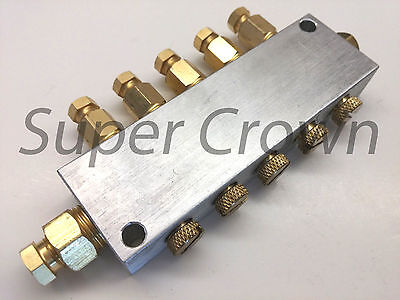
Adjustable Aluminum Lube Oil Joint Manifold Seat Bijur Grinder Showa CNC7 8 10 1 | eBay
One adjustable distributing joint or seat with ferrules and compression sleeves, for Ф4mm tubing or pipe; for all import conventional machines, presses, machining centers, CNC turning lathes, etc. 144 x 15 x 30mm/ 5.67" x 0.59" x 1.18"(L W H).
www.ebay.com
I then replaced with this one. It's not quite as nice as the first one, but the adjusters are smaller, and it works just as well.
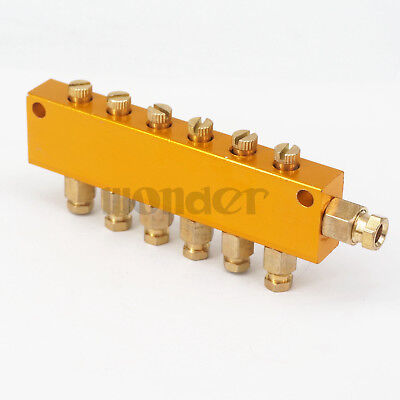
Aluminum 6 Way Adjustable Lube Distributor Value Manifold Block 6mm in 4mm out | eBay
Find many great new & used options and get the best deals for Aluminum 6 Way Adjustable Lube Distributor Value Manifold Block 6mm in 4mm out at the best online prices at eBay! Free shipping for many products!
www.ebay.com
@Firebrick43 I must be an idiot, I can find a bunch of companies that make those dividing valves, trabon, lincoln, bijur but no where to actually buy them besides a few random ones on ebay that don't have the indicator pins. The more I think about it the more I want to just do it right once instead of tearing the machine apart twice.
- Joined
- Jan 20, 2015
- Messages
- 359
Trabon MSP valve stack
Here is an ebay add for one. will lube 8 ports. It also has the indicator on the side. How many points do you have to do? and what are they
Are you leaning towards one system? While trabon is nice, that does mean that vogel/skf or bijur wont work as well.
Here is an ebay add for one. will lube 8 ports. It also has the indicator on the side. How many points do you have to do? and what are they
Are you leaning towards one system? While trabon is nice, that does mean that vogel/skf or bijur wont work as well.
Last edited:
Where would you mount one of those trabon units? They look large. If you can't mount it to the side if the saddle then you'll need a bunch of flexible hoses running to the saddle with enough length for the full travel of the Y axis.
Supercrown105 on eBay also has manifolds with individual volumetric ports and I believe check valves as well. I don't know how to determine what CC of oil each port would need to make sure you order the right unit.
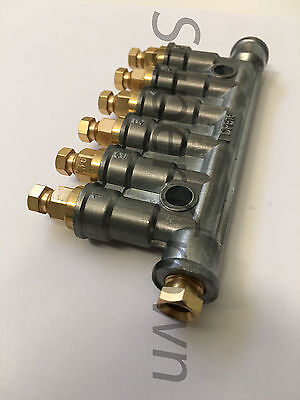
Supercrown105 on eBay also has manifolds with individual volumetric ports and I believe check valves as well. I don't know how to determine what CC of oil each port would need to make sure you order the right unit.

Super Crown Dester Plunger Piston Action Volumetric Oil CNC Showa DPB-16 0.10CC | eBay
This item is a part of a lubrication system, and it is normally installed on Japanese made machines. (For example: MORI SEIKI / HITACHI etc.). Design and specifications are similar to Showa’s DPB valves.
www.ebay.com
- Joined
- Jan 20, 2015
- Messages
- 359
That is a consideration, and valid. you would need two blocks on y axis depending on how you do it and there are two block manifolds available so it would not be that big but still larger than the showa style you listed. And for that reason, a trabon style probably is not the best fit for a small bench top machine.Where would you mount one of those trabon units? They look large. If you can't mount it to the side if the saddle then you'll need a bunch of flexible hoses running to the saddle with enough length for the full travel of the Y axis.
Supercrown105 on eBay also has manifolds with individual volumetric ports and I believe check valves as well. I don't know how to determine what CC of oil each port would need to make sure you order the right unit.

Super Crown Dester Plunger Piston Action Volumetric Oil CNC Showa DPB-16 0.10CC | eBay
This item is a part of a lubrication system, and it is normally installed on Japanese made machines. (For example: MORI SEIKI / HITACHI etc.). Design and specifications are similar to Showa’s DPB valves.www.ebay.com
The showa style manifolds you show are similar/clones to the vogel/skf units. Bijur makes a compatible model as well. Its very muddy as to which came first with this specific style. I am not sure that they are interchangeable per say but theory of op is the same and while I don't know the quality of the Chinese clones, showa makes nice units from the okumas/toyoda/mazak i have worked on. The only issues with the showa units I have had to fix is the little motors on the tanks conk out occasionally but that was in 24/7 use in on very large mill turns so they are cycling pretty consistently and were over 10-12 years old. I don't recall changing one on the large 800mm HMC's.
If you notice in the pic there is a .16 on the brass hex where it screws into the manifold. Typically there is a 03, 05, 10, 15, or 20 marked here on a showa unit. This is the volume of oil that is dispensed with each cycle. I don't know why this chinese clone is marked .16 which is the model number not the CC volume. A cycle is going to full pressure(which pumps the oil metered the last cycle) and then goes to zero pressure as the checks open and allow oil into the chamber for the next cycle.
IMHO .10 cc per cycle is adequate for the ways, but "way" to much for the ball screw nuts. you would want to remove that plunger/unit and replace it with a .03 cc unit. Even that is probably excessive for such a small machine but will be ok.
Vogel/skf, Showa, and Some bijur systems.
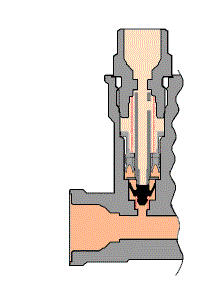
A progressive type system such as trabon(others have functionally similar products)
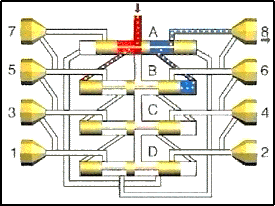
Last edited:


